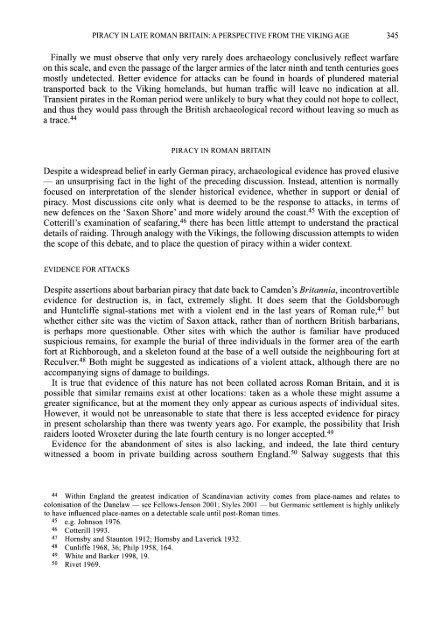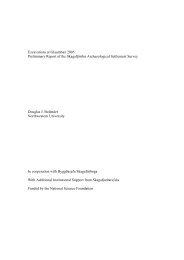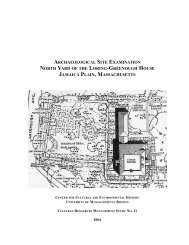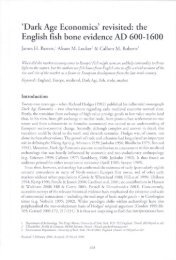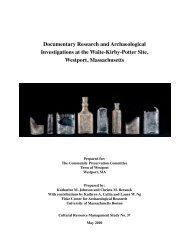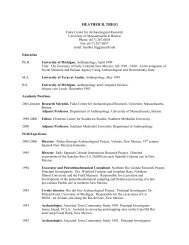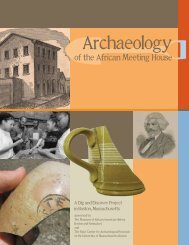Piracy in Late Roman Britain: A Perspective from the ... - Fiske Center
Piracy in Late Roman Britain: A Perspective from the ... - Fiske Center
Piracy in Late Roman Britain: A Perspective from the ... - Fiske Center
Create successful ePaper yourself
Turn your PDF publications into a flip-book with our unique Google optimized e-Paper software.
PIRACY IN LATE ROMAN BRITAIN: A PERSPECTIVE FROM THE VIKING AGE<br />
345<br />
F<strong>in</strong>ally we must observe that only very rarely does archaeology conclusively reflect warfare<br />
on this scale, and even <strong>the</strong> passage of <strong>the</strong> larger armies of <strong>the</strong> later n<strong>in</strong>th and tenth centuries goes<br />
mostly undetected. Better evidence for attacks can be found <strong>in</strong> hoards of plundered material<br />
transported back to <strong>the</strong> Vik<strong>in</strong>g homelands, but human traffic will leave no <strong>in</strong>dication at all.<br />
Transient pirates <strong>in</strong> <strong>the</strong> <strong>Roman</strong> period were unlikely to bury what <strong>the</strong>y could not hope to collect,<br />
and thus <strong>the</strong>y would pass through <strong>the</strong> British archaeological record without leav<strong>in</strong>g so much as<br />
a trace.44<br />
PIRACY IN ROMAN BRITAIN<br />
Despite a widespread belief <strong>in</strong> early German piracy, archaeological evidence has proved elusive<br />
- an unsurpris<strong>in</strong>g fact <strong>in</strong> <strong>the</strong> light of <strong>the</strong> preced<strong>in</strong>g discussion. Instead, attention is normally<br />
focused on <strong>in</strong>terpretation of <strong>the</strong> slender historical evidence, whe<strong>the</strong>r <strong>in</strong> support or denial of<br />
piracy. Most discussions cite only what is deemed to be <strong>the</strong> response to attacks, <strong>in</strong> terms of<br />
new defences on <strong>the</strong> 'Saxon Shore' and more widely around <strong>the</strong> coast.45 With <strong>the</strong> exception of<br />
Cotterill's exam<strong>in</strong>ation of seafar<strong>in</strong>g,46 <strong>the</strong>re has been little attempt to understand <strong>the</strong> practical<br />
details of raid<strong>in</strong>g. Through analogy with <strong>the</strong> Vik<strong>in</strong>gs, <strong>the</strong> follow<strong>in</strong>g discussion attempts to widen<br />
<strong>the</strong> scope of this debate, and to place <strong>the</strong> question of piracy with<strong>in</strong> a wider context.<br />
EVIDENCE FOR ATTACKS<br />
Despite assertions about barbarian piracy that date back to Camden's Britannia, <strong>in</strong>controvertible<br />
evidence for destruction is, <strong>in</strong> fact, extremely slight. It does seem that <strong>the</strong> Goldsborough<br />
and Huntcliffe signal-stations met with a violent end <strong>in</strong> <strong>the</strong> last years of <strong>Roman</strong> rule,47 but<br />
whe<strong>the</strong>r ei<strong>the</strong>r site was <strong>the</strong> victim of Saxon attack, ra<strong>the</strong>r than of nor<strong>the</strong>rn British barbarians,<br />
is perhaps more questionable. O<strong>the</strong>r sites with which <strong>the</strong> author is familiar have produced<br />
suspicious rema<strong>in</strong>s, for example <strong>the</strong> burial of three <strong>in</strong>dividuals <strong>in</strong> <strong>the</strong> former area of <strong>the</strong> earth<br />
fort at Richborough, and a skeleton found at <strong>the</strong> base of a well outside <strong>the</strong> neighbour<strong>in</strong>g fort at<br />
Reculver.48 Both might be suggested as <strong>in</strong>dications of a violent attack, although <strong>the</strong>re are no<br />
accompany<strong>in</strong>g signs of damage to build<strong>in</strong>gs.<br />
It is true that evidence of this nature has not been collated across <strong>Roman</strong> Brita<strong>in</strong>, and it is<br />
possible that similar rema<strong>in</strong>s exist at o<strong>the</strong>r locations: taken as a whole <strong>the</strong>se might assume a<br />
greater significance, but at <strong>the</strong> moment <strong>the</strong>y only appear as curious aspects of <strong>in</strong>dividual sites.<br />
However, it would not be unreasonable to state that <strong>the</strong>re is less accepted evidence for piracy<br />
<strong>in</strong> present scholarship than <strong>the</strong>re was twenty years ago. For example, <strong>the</strong> possibility that Irish<br />
raiders looted Wroxeter dur<strong>in</strong>g <strong>the</strong> late fourth century is no longer accepted.49<br />
Evidence for <strong>the</strong> abandonment of sites is also lack<strong>in</strong>g, and <strong>in</strong>deed, <strong>the</strong> late third century<br />
witnessed a boom <strong>in</strong> private build<strong>in</strong>g across sou<strong>the</strong>rn England.5o Salway suggests that this<br />
44 With<strong>in</strong> England <strong>the</strong> greatest <strong>in</strong>dication of Scand<strong>in</strong>avian activity comes <strong>from</strong> place-names and relates to<br />
colonisation of <strong>the</strong> Danelaw - see Fellows-Jenson 2001; Styles 2001 - but Germanic settlement is highly unlikely<br />
to have <strong>in</strong>fluenced place-names on a detectable scale until post-<strong>Roman</strong> times.<br />
45 e.g. Johnson 1976.<br />
46 Cotterill 1993.<br />
47 Hornsby and Staunton 1912; Hornsby and Laverick 1932.<br />
48 Cunliffe 1968, 36; Philp 1958, 164.<br />
49 White and Barker 1998, 19.<br />
50 Rivet 1969.


